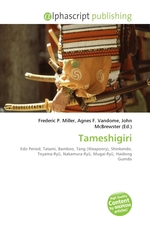Tameshigiri
Frederic P. Miller, Agnes F. Vandome, John McBrewster
бумажная книга
Please note that the content of this book primarily consists of articles available from Wikipedia or other free sources online. Tameshigiri is the Japanese art of target test cutting. The kanji literally mean "test cut" (tameshi giri). This practice was popularized in the Edo period (17th century) for testing the quality of swords and continues through the present day. During the Edo period, only the most skilled swordsmen were chosen to test swords, so that the swordsman's skill was not a variable in how well the sword cut. The materials used to test swords varied greatly. Some substances were wara (rice straw), goza (the top layer of tatami mats), bamboo, and thin steel sheets. In addition, there were a wide variety of cuts used on the cadavers, from tabi-gata (ankle cut) to O-kesa (diagonal cut from shoulder to opposite hip). The names of the types of cuts on cadavers show exactly where on the body the cut was made. Older swords can still be found today that have inscriptions on their nakago (tang) that say things such as, "5 bodies with Ryu Guruma (hip cut)".
Данное издание не является оригинальным. Книга печатается по технологии принт-он-деманд после получения заказа.


